| |
A
Slice Of The Du Maurier Jazz Festival
Vancouver BC, 24-26 June 2001
by Alan Jones
September 2001
The Vancouver Du Maurier Jazz Festival is one of many that occur annually
in Canada, one which is earning a competitive reputation for assembling
the most colorful threads of the jazz tapestry in a most timely fashion.
This 16th year featured more than 1500 jazz musicians from around
the world, performing at over forty different venues. Du Maurier's
organizers have their ears close to the rails of the jazz progression,
thus booking in advance such headliners as Dave Douglas, John Scofield,
Louis Hayes, Curtis Fuller, Joshua Redman, Roy Hargrove, Kurt Rosenwinkel,
Tim Berne, and Ellery Eskelin's acclaimed trio with accordionist Andrea
Parkins and drummer Jim Black. For all of these promising acts, the
most anticipated event of the festival took place within the opening
weekend—the Barry Guy New Orchestra, an international concoction
of some of the most prolific instrumentalists in contemporary jazz.
While inspired by Barry Guy's renowned London Jazz Composers Orchestra,
his New Orchestra purports to take jazz composition and improvisation
into a different direction. Guy does so by combining two of his own
working trios—one with Evan Parker (saxophones) and Paul Lytton
(percussion), the other with Swedes Mats Gustafsson (saxophones) and
Raymond Strid (percussion)—around the functional center of pianist
Marilyn Crispell. Brass and extra woodwinds then augment the unit.
The assemblage of the Barry Guy New Orchestra was a blessing, when
you consider the logistics involved with organizing an international
band. Multiple contributors, non-profit and governmental, fought migraines
in organizing the members' stay. Their booking also allowed for multiple
possibilities for the ticket holders and for the players themselves.
For two days prior to the New Orchestra's single performance on Sunday
night, the musicians could be heard in a variety of settings spread
across four separate venues, each of the exhibitions a marathon of
free improvisation unto itself. The performances were both primer
and filler for hungry audiences.
—friday—
On Friday, opening night of the festival, Barry Guy and Mats Gustafsson
joined Vancouver composer/instrumentalist Randy Raine-Reusch for a
set of meditative free improvisation. Raine-Reusch, a master of eclectic
East Asian wind and string instruments, was perfectly suited for the
foundation laid by Guy and Gustafsson, which was a blend of their
own telepathic skills and the uniqueness of the setting itself. The
stage was the limestone floors of Dr. Sun Yat-Sen's Chinese Classical
Garden, in the Chinatown section of Vancouver.
The garden is said to be "a microcosm of nature and man's place within
it". Honored for the early-20th century Chinese leader of the same
name, it is a stunning call back to the architecture of the Ming Dynasty,
adorned with mahogany wood, ornate tile patterns, bonsai trees, bamboo,
and a contemplation pool brewing with Koi fish.
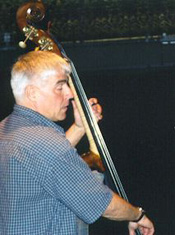 It was
a natural atmosphere for the trio, who seemed to play not just for
their audience, but also as an extension of the serene elements of
their surroundings, both organic and immaterial. The trio settled
into the first piece with Raine-Reusch blowing a sumpoton—a
Sabahan mouth organ with several reed-fitted pipes affixed to a gourd
wind chamber. Guy joined on bass with Gustafsson close behind on tenor
saxophone, and soon the trio was engaged in a thirty minute improvisation
that was as incomprehensible as it was awe inspiring. The unsuspecting
audience was taken for a colorful ride that called to Eastern mysticism
and the permutations of European free improv alike. As remarkable
as the trio played, nothing was more endearing than the way in which
music fused with environs. At one point during the set, with Gustafsson
taking a soft solo on fluteophone—Gustafsson's creation, a flute
outfitted with the mouthpiece of a saxophone—a small group of
gulls soared overhead, inspiring a brief burst of call and response
between the birds and the reedman. Other pieces featured Raine-Reusch
on two fretless Chinese zithers, using fingers, slides, brushes and
mallets to extract a mélange of tones and inflections. During the
second improvisation, following an excursion colored by straight ethereal
tones from each instrument, Guy constructed a weighty solo, moving
violently up and down the strings. With intense and concentrated energy,
he maintained communication with his stage mates; upon hearing percussive
tones from the Chinese zither, Guy began mimicking with mallets on
the strings of the double bass. Gustafsson occasionally came alive
on baritone saxophone and Guy never failed to push the group into
new territory with thoughtful submissions and an against-the-grain
idealism that was both commanding and stimulating. It was
a natural atmosphere for the trio, who seemed to play not just for
their audience, but also as an extension of the serene elements of
their surroundings, both organic and immaterial. The trio settled
into the first piece with Raine-Reusch blowing a sumpoton—a
Sabahan mouth organ with several reed-fitted pipes affixed to a gourd
wind chamber. Guy joined on bass with Gustafsson close behind on tenor
saxophone, and soon the trio was engaged in a thirty minute improvisation
that was as incomprehensible as it was awe inspiring. The unsuspecting
audience was taken for a colorful ride that called to Eastern mysticism
and the permutations of European free improv alike. As remarkable
as the trio played, nothing was more endearing than the way in which
music fused with environs. At one point during the set, with Gustafsson
taking a soft solo on fluteophone—Gustafsson's creation, a flute
outfitted with the mouthpiece of a saxophone—a small group of
gulls soared overhead, inspiring a brief burst of call and response
between the birds and the reedman. Other pieces featured Raine-Reusch
on two fretless Chinese zithers, using fingers, slides, brushes and
mallets to extract a mélange of tones and inflections. During the
second improvisation, following an excursion colored by straight ethereal
tones from each instrument, Guy constructed a weighty solo, moving
violently up and down the strings. With intense and concentrated energy,
he maintained communication with his stage mates; upon hearing percussive
tones from the Chinese zither, Guy began mimicking with mallets on
the strings of the double bass. Gustafsson occasionally came alive
on baritone saxophone and Guy never failed to push the group into
new territory with thoughtful submissions and an against-the-grain
idealism that was both commanding and stimulating.
At show's end the audience stirred and reflected. Some attempted to
deconstruct the sounds that were experienced, others engaged in the
judgmental diarrhetics that so often plague the free jazz crowd—"Wow,
that was…well, I don't know. Fantastic." "A perfect match, Randy was
amaaaazing." "I don't know if I liked it or not." "…Matt Shipp…No,
I don't care for that crowd." But all minds were immediately occupied
with getting to the next venue for Steve Lacy, and with what would
come of the possibilities in a rare midnight concert at the new and
trendy Studio 16.
Steve Lacy appeared at the Vancouver East Cultural Center (more on
this venue below) with his regular trio-bassist Jean-Jacques Avenel
and drummer John Betsch. Joining the group were trombonist George
Lewis and Lacy's wife, vocalist/violinist Irene Aebi. I had heard
the trio in Seattle earlier in the year, so it was nice to have the
expanded instrumentation. It didn't matter that the set list was nearly
identical to that of the Seattle show-the music was extraordinary,
and you can't lose having Lewis in the lineup. The group commenced
with a reading of my favorite Lacy tune, "The Bath". Lewis took the
first solo, his trombone an extension of himself. The solo was colored
with multiphonics and excitation before moving slowing into a lazy
New Orleans stride.
Following "The Bath" the quintet proceeded into its "Beat Suite",
a colloquy that pays tribute to Beat poets through musical interpretation
of selected works, with Aebi singing the lyrics as opening and closing
heads. The first piece was "Inside My Head", taken from an obscure
Robert Creeley poem, which was patterned with various breaks for the
roller coaster lead. Lacy took the first solo, vivacious and happy.
Lewis followed with something linear, delving into the trombone's
low register. He got a chuckle out of the audience, capping off his
solo with a traditional Vaudevillian wrap. Aebi began the next tune
singing a stanza from Lew Welch's "Ring a Bell". Lacy had a vibrant
chromatic solo peppered with high harmonics. Lewis followed, creating
huge oscillations with some tremolo blowing while simultaneously employing
a plunger mute. The group then performed "Race", with Aebi singing
words taken from a newspaper article. It was about this time that
I began to get annoyed by the audience's robotic applause after each
solo and between numbers. There's something about that tradition that
seems intrusive and obligatory. The quintet continued with the suite,
and made some dedications along the way. One piece was played in memory
of Leroy Vinnegar and Billy Higgins. Lacy "played" Kerouac's "Wave
Lover" as a tribute to Art Farmer.
Lacy's killer "Blinks" found its way into the flow of the "Beat Suite",
setting Avenel and Betsch ablaze. Finally, the leader showed some
restraint by having only one Thelonious Monk tune in his set list.
The group delivered a scorching take of "Bye-Ya", an appropriately
titled closing number. The music was tasty and the band seemed to
have genuinely enjoyed themselves. It was good to experience the subtle
theatrics of George Lewis.
The show had me in a good mood and I was ready to do some damage.
After Steve Lacy's show I asked my buddy if we were going out for
beers. Puzzled, he asked, "Wouldn't you like to go hear Gush?"
"Gush? Hmm…Why does that sound familiar?"
"It's the Swedes. Mats, Raymond Strid and Sten Sandell."
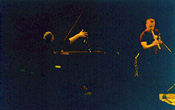 I
had known of Gush but never heard their music. Sten Sandell is a commanding
pianist who is reminiscent of the Cecil Taylor tradition, but with
a discriminating style all his own. And Raymond Strid, the versatile
percussionist who has been a fixture in European improv for several
years. The three of them-Mats Gustafsson, Sandell and Strid-comprise
the Swedish creative trio, Gush, and an appearance in North America
was extremely rare. I
had known of Gush but never heard their music. Sten Sandell is a commanding
pianist who is reminiscent of the Cecil Taylor tradition, but with
a discriminating style all his own. And Raymond Strid, the versatile
percussionist who has been a fixture in European improv for several
years. The three of them-Mats Gustafsson, Sandell and Strid-comprise
the Swedish creative trio, Gush, and an appearance in North America
was extremely rare.
A midnight concert for the nocturnal was fitting for this group. Studio
16 was packed to the back with a young crowd with a mean age of about
twenty-three. Newcomers and seasoned free jazz enthusiasts were scattered
throughout the venue.
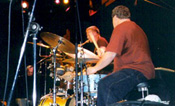 Gush opened with a very stylish Gustafsson blowing and tapping a series
of percussives that sounded like distant gunfire. Strid responded
spasmodically on the rims of his snare. The mood turned from ambient
to galvanized when, beckoning Sandell to join the conversation, Gustafsson
arose from a crouched position with a sweeping lateral arc, throwing
a beefy tone from one side of the stage to the other. Light, trebly
piano riffs began to circulate throughout the venue. The trio set
the house on fire. I was intrigued to see a guy of about twenty standing
directly in front of Gustafsson. The kid's eyes were closed and his
head was bobbing trance-like. When the music pulsed, so did he. He
came down with it. And back up again. It's a shame that I couldn't
stick around to see if his head exploded. I was tired and my buddy
had to get home. But the thirty minutes that I heard of Gush was some
of the best time spent in Vancouver that weekend. Sometimes a half-hour
is all you need to win a new fan.
Gush opened with a very stylish Gustafsson blowing and tapping a series
of percussives that sounded like distant gunfire. Strid responded
spasmodically on the rims of his snare. The mood turned from ambient
to galvanized when, beckoning Sandell to join the conversation, Gustafsson
arose from a crouched position with a sweeping lateral arc, throwing
a beefy tone from one side of the stage to the other. Light, trebly
piano riffs began to circulate throughout the venue. The trio set
the house on fire. I was intrigued to see a guy of about twenty standing
directly in front of Gustafsson. The kid's eyes were closed and his
head was bobbing trance-like. When the music pulsed, so did he. He
came down with it. And back up again. It's a shame that I couldn't
stick around to see if his head exploded. I was tired and my buddy
had to get home. But the thirty minutes that I heard of Gush was some
of the best time spent in Vancouver that weekend. Sometimes a half-hour
is all you need to win a new fan.
—saturday—
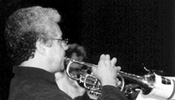 As a
taste of exactly what type of modulation the brass section would bring
to the Barry Guy New Orchestra, trumpeter Herb Robertson, trombonist
Johannes Bauer, and tubaist Per-Åke Holmlander met for a recital of
eclectic chamber music in Saturday's early evening. The event took
place on the upper floor of the homey Western Front, East Vancouver's
multi-cultural venue for electronics and performing arts. The only
drawback to the cozy room was the rickety old chairs that Fats Waller
ticket holders might once have used. No WD-40 on hand, we circumvented
the problem by not moving for an hour. Though the sun had not yet
begun to set, the room was dark, save for tactically placed lighting
that was centered upon the three musicians. As a
taste of exactly what type of modulation the brass section would bring
to the Barry Guy New Orchestra, trumpeter Herb Robertson, trombonist
Johannes Bauer, and tubaist Per-Åke Holmlander met for a recital of
eclectic chamber music in Saturday's early evening. The event took
place on the upper floor of the homey Western Front, East Vancouver's
multi-cultural venue for electronics and performing arts. The only
drawback to the cozy room was the rickety old chairs that Fats Waller
ticket holders might once have used. No WD-40 on hand, we circumvented
the problem by not moving for an hour. Though the sun had not yet
begun to set, the room was dark, save for tactically placed lighting
that was centered upon the three musicians.
The concert was given from the platform of dynamic expression rather
than as a collective "musical" improvisation. It was more drama than
music. One could easily imagine mimes improvising through scenarios
and foreign dialogues—each member of the trio frequently choosing
from an arsenal of mutes and toys to modify their tones and methods
of expression. Much of the performance had Robertson and Bauer taking
their instruments to radical extremes, speaking in tongues to one
another over the tuba's loose rumblings. Bauer often submitted a vibrato
so abrasive that his trombone could have easily been mistaken for
a bass sax. In a later segment, Bauer began mumbling in monotone,
kicking his head from side to side for inflection and emphasis. This
blabbery was delivered softly through a plastic mute, sans instrument,
that could be likened to a child's paper party favor. He quickly inserted
the mute into the trombone's bell, picking up where he left off in
his ramblings, this time through the mouthpiece of his instrument.
All eyes were on Bauer; minds wondered if he would begin translating
with traditional blowing, or if he had just momentarily gone mad.
Metallics erupted from Holmlander's position, fingernails tapping
every conduit of his tuba. Then Robertson exploded, shrieking through
the high register of his muted trumpet. The trio rearranged the chaos
by occasionally playing clean tones, but then quickly returning to
derangement. The concert was tied up with a soft detour into traditional
sounds, each musician subsiding into reflective silence.
Those who were expecting an appetizer of pensive chamber music were
likely disappointed. But those craving the possibilities of impressionistic
improv were surely satisfied. You have to wonder what fuels and inspires
such musicians to bequeath their audience with gestures so personal
and unfamiliar. Johannes Bauer believes simplicity is disguised by
drama, "It's the most unintellectual thing you could imagine, really."
Hmmm.
With all of the excitement and preoccupation with its coming performance,
the Barry Guy New Orchestra had a close rival in a unique double billing.
Barry Guy's performing trios are tops among the most innovative and
thrilling free jazz groups of the past two decades. Two of these groups
played at the Vancouver East Cultural Center on Saturday evening.
To fortify the possibilities of both performances, Guy invited pianist
Marilyn Crispell-a close friend and vision sharer of Guy's-who has
played and recorded with these groups before. But, in keeping with
the nature of any project involving Barry Guy, it was difficult to
hold expectations.
The "Cultch", as locals know the venue, is a handsome, renovated church
located in Vancouver's east side. Its auditorium—a floor section
and a lower balcony, all-wood—can compete with the best of them
in terms of comfort and atmosphere. Sound circulates freely there,
but not to the point of absorption; a good thing, taking in mind the
musicians that were aboard.
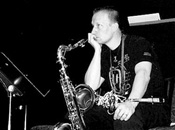 The
two groups have surprisingly different sounds, considering the similar
instrumentation. The first—Gustafsson, Guy, and percussionist
Raymond Strid—is an energetic one, visibly and musically. Gustafsson
is a powerful player in any setting, whether alone or alongside saxophonist
Ken Vandermark in their mighty AALY Trio. Strid complements the saxophonist's
intensity with an uncommon mix of subtlety and aggressive counterpoint—always
reading, never drifting. While versed in the same methods of free
improvisation as his younger counterpart, Evan Parker's approach is
perhaps the ultimate antipode to that of Gustafsson. Where Gustafsson
aggressively probes the highest timbres and edgiest depths of his
instrument, Parker sounds almost passively scrutinizing. Parker takes
his time, appealing to the possibilities of beauty. Both saxophonists
also employ circular breathing techniques to wide effect, exposing
a multitude of color (Parker) or migratory cacophonies (Gustafsson)
along the way. Percussionist Paul Lytton completes the second triad,
bringing a shimmery stamp to the nomadic inquiries of the trio. The
two groups have surprisingly different sounds, considering the similar
instrumentation. The first—Gustafsson, Guy, and percussionist
Raymond Strid—is an energetic one, visibly and musically. Gustafsson
is a powerful player in any setting, whether alone or alongside saxophonist
Ken Vandermark in their mighty AALY Trio. Strid complements the saxophonist's
intensity with an uncommon mix of subtlety and aggressive counterpoint—always
reading, never drifting. While versed in the same methods of free
improvisation as his younger counterpart, Evan Parker's approach is
perhaps the ultimate antipode to that of Gustafsson. Where Gustafsson
aggressively probes the highest timbres and edgiest depths of his
instrument, Parker sounds almost passively scrutinizing. Parker takes
his time, appealing to the possibilities of beauty. Both saxophonists
also employ circular breathing techniques to wide effect, exposing
a multitude of color (Parker) or migratory cacophonies (Gustafsson)
along the way. Percussionist Paul Lytton completes the second triad,
bringing a shimmery stamp to the nomadic inquiries of the trio.
Slightly altering the one-for-all philosophy that propels these trios
into fascinating territory, Guy and Crispell were the common denominator
shared by the two groups. That Guy is so closely and effortlessly
compatible with both sets of musicians is affirmation of his own far-reaching
talent.
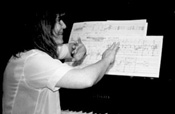 Crispell
has found her way into the trios through mutual admiration. She and
Guy have worked together on many occasions and share a deep fondness
for each other's work. From his own experience, Guy is fond of the
strength that the pianist can bring to any performance, "With Marilyn
joining both trios…you get different inflections and a different focus
according to the way the group dynamic works." Having any pianist
aboard with these two trios is an exercise in both trust and potential. Crispell
has found her way into the trios through mutual admiration. She and
Guy have worked together on many occasions and share a deep fondness
for each other's work. From his own experience, Guy is fond of the
strength that the pianist can bring to any performance, "With Marilyn
joining both trios…you get different inflections and a different focus
according to the way the group dynamic works." Having any pianist
aboard with these two trios is an exercise in both trust and potential.
Gustafsson/Crispell/Guy/Strid began their set with an airy bass and
sax duet. Hints of themes surfaced initially, only to quickly disappear,
with one or two remnant notes circulating around the stage. The set
was off on a hobbled foot as each musician tried to attenuate to the
sound environment and the dynamics of the venue. Gustafsson had the
first searing solo. Flailing wildly about with his tenor, he built
upon fragments set forth by the bass, Strid crashing asynchronously
behind him. Sax and drums connected for a cochlear resonance that
elevated the stage even as Guy and Crispell contributed weight, hammering
furiously into their instruments. The collective became noise that
refused to abate.
The music subsided only after Gustafsson must have needed a rest.
The saxophonist dominated the majority of the set, seeming to care
for progression only when he was blowing. Perhaps he had something
to prove for some jokester who, between numbers, requested that the
group play a Cramps tune, referring to Gustafsson's black T-shirt
bearing the band's name. Later in a separate piece, when Crispell's
turn for a solo came, she re-entered delicately by toying with the
keys, but it was in vain. Her piano was miked poorly, and Gustafsson
added to that frustration, allowing little space for her to move.
But the music was still contagious, even with mediocre sound that
the mixman was never able to perfect.
Following a brief intermission (and a couple of beers), Parker/Crispell/Guy/Lytton
came to the stage. The ensemble that has recently come to be recognized
as the "After Appleby" group—after a performance of the same
name on Leo Records—had me reeling with anticipation. I have
become a rabid fan of Parker's over the past year, and this night
was my first to hear him live.
 Parker
opened with one of his trademark soprano saxophone solos, circular
breathing the entire way. His sounds came from the middle register
of his instrument with spotty excursions into the higher spectrum.
He stood immovable before us, anticipating the entry of his stagemates.
Lytton came first. The saxophone arpeggios were soon enveloped in
crashes and high-end shimmers, carefully selected from Lytton's percussion
warehouse. Crispell came aboard on the high keys, followed by Guy,
and then ascension. The band flawlessly connected as a single, sonorous
unit for a good ten minutes of spectacular improv. Parker
opened with one of his trademark soprano saxophone solos, circular
breathing the entire way. His sounds came from the middle register
of his instrument with spotty excursions into the higher spectrum.
He stood immovable before us, anticipating the entry of his stagemates.
Lytton came first. The saxophone arpeggios were soon enveloped in
crashes and high-end shimmers, carefully selected from Lytton's percussion
warehouse. Crispell came aboard on the high keys, followed by Guy,
and then ascension. The band flawlessly connected as a single, sonorous
unit for a good ten minutes of spectacular improv.
Each musician had ample solo space, and the solos bordered on majestic.
Lytton and Crispell combined for a fragile three minutes that were
easily the highlight of the set. When Parker put down his soprano,
it was as if he never came back. He and Guy made eye contact, and
soon the saxophonist was wielding the tenor. He came in with brief
bursts, followed by a series of circular riffs, and then stopped.
Parker began to pace the stage as if he was searching for just the
right vantage point to reenter with more music. He tried two, maybe
three times to join the collective and then bowed out for an extended
time, resolving to stand at the side of the stage. If anything was
wrong, it was not obvious to me. The mix was considerably better for
this group and Crispell seemed to be only distracted by Parker's lack
of enthusiasm.
The quartet continued to play for forty minutes or so, and Parker
eventually found his entry point. The performers were unexciting for
the most part (the exception was Guy, who was on fire the entire night),
but the music had plenty of captivating moments. I experienced a few
brief episodes of goosebumps during the eighty minutes that they played.
And that is all that mattered.
—sunday—
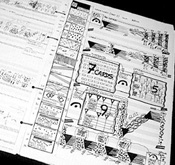 As
exciting as the previous concerts were, the Barry Guy New Orchestra
was easily the favorite. The Cultch's stage was spectacular. Paul
Lytton and Raymond Strid's drum kits were nestled neatly in the back,
their percussion equipment strewn about the floor as if a four-year-old
had just had his way with a roomful of toys. In front of Lytton (left)
was Herb Robertson's trumpet seat and Bauer and Holmlander were forward
of Strid (right). Crispell was extreme left and Swiss multi-instrumentalist
Hans Koch was at extreme right with soprano saxophone, bass clarinet
and the cumbersome contrabass clarinet. Evan Parker and Mats Gustafsson
were forward of the brass and Barry Guy's conductor's platform was
front-center. While anticipating the performance, many concertgoers
were transfixed on the complex sheet music at the piano, a system
of classic notation interspersed with cryptic diagrams and sketches. As
exciting as the previous concerts were, the Barry Guy New Orchestra
was easily the favorite. The Cultch's stage was spectacular. Paul
Lytton and Raymond Strid's drum kits were nestled neatly in the back,
their percussion equipment strewn about the floor as if a four-year-old
had just had his way with a roomful of toys. In front of Lytton (left)
was Herb Robertson's trumpet seat and Bauer and Holmlander were forward
of Strid (right). Crispell was extreme left and Swiss multi-instrumentalist
Hans Koch was at extreme right with soprano saxophone, bass clarinet
and the cumbersome contrabass clarinet. Evan Parker and Mats Gustafsson
were forward of the brass and Barry Guy's conductor's platform was
front-center. While anticipating the performance, many concertgoers
were transfixed on the complex sheet music at the piano, a system
of classic notation interspersed with cryptic diagrams and sketches.
When Guy appeared on stage it was like a release among the audience.
Many of the faces were familiar, having attended all of the group's
fledgling shows throughout the weekend, and were in deep anticipation
to hear the New Orchestra. Guy announced his orchestra, its intentions,
and then positioned himself at the conductor's stand.
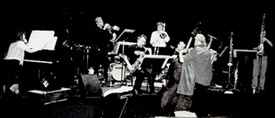 The
concert was divided into two sets. The opening set was a forty minute
reading of a single movement from Guy's own "Nasca Lines", a multi-part
piece originally written for an orchestra of twenty-three. The orchestra
then followed an intermission with "Inscape-Tableaux", the music from
Guy's record released earlier this year on Intakt. The
concert was divided into two sets. The opening set was a forty minute
reading of a single movement from Guy's own "Nasca Lines", a multi-part
piece originally written for an orchestra of twenty-three. The orchestra
then followed an intermission with "Inscape-Tableaux", the music from
Guy's record released earlier this year on Intakt.
The music for "Nasca Lines" was inspired by the mysterious geoglyphs
permanently etched into Peru's coastal desert. The markings are thought
to have served a purpose similar to that of the Pyramids—mysterious
because of their construction to be appreciated from above, 1500 years
before airplanes. The music is traditionally sequenced; however, at
certain points the charts direct selected musicians to improvise by
randomly selecting from 16 "cards" in the margin of the sheet music.
The "cards" were a series of spatial and directional diagrams. For
instance, one card was dotted with a series of "down" arrows, indicating
to the improviser that he/she was to launch a sequence of low stabs
on his/her instrument. Another had stars and moons, suggesting that
ambience should be achieved…
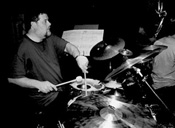 The
performance was quite climactic. Each soloist had plenty of room to
contribute. It was most intriguing when the improvisation sections
were carried by predetermined clusters of musicians, rather than by
a single soloist. This required a segregated trio or quartet to be
attuned to itself, all the while being attentive to the written parts
being played simultaneously by the remainder of the orchestra. An
interesting moment featured Bauer, Guy, and Strid improvising off
of "cards". Bauer took a memorable trombone solo that was interweaved
with raucous bass sounds. The group was both rousing and quiescent,
intricately layered over a slow wave of moods ranging from energetic
to melancholy. The final five minutes were a rarefraction of increasingly
quieted swells. We were on the edge of our seats waiting for an explosion,
but Guy was fixed on bringing the orchestra down to calming inertia.
The brass billowed softly while Crispell generated delicate assonant
lines, at pace with the conductor's lazy cadence. The last notes came
from the collective, spiced with a final symphonious chord from the
piano. The
performance was quite climactic. Each soloist had plenty of room to
contribute. It was most intriguing when the improvisation sections
were carried by predetermined clusters of musicians, rather than by
a single soloist. This required a segregated trio or quartet to be
attuned to itself, all the while being attentive to the written parts
being played simultaneously by the remainder of the orchestra. An
interesting moment featured Bauer, Guy, and Strid improvising off
of "cards". Bauer took a memorable trombone solo that was interweaved
with raucous bass sounds. The group was both rousing and quiescent,
intricately layered over a slow wave of moods ranging from energetic
to melancholy. The final five minutes were a rarefraction of increasingly
quieted swells. We were on the edge of our seats waiting for an explosion,
but Guy was fixed on bringing the orchestra down to calming inertia.
The brass billowed softly while Crispell generated delicate assonant
lines, at pace with the conductor's lazy cadence. The last notes came
from the collective, spiced with a final symphonious chord from the
piano.
Following the intermission the orchestra played "Inscape-Tableaux"
in its seventy-minute entirety. The composed areas were delivered
note for note, splattered with fresh improv that was perfectly executed
by the orchestra. "Inscape-Tableaux" began with a piercing thrust.
Johansson followed with a ragged line on trombone, and we were off.
Strid, insatiable with his array of percussion gadgets, cauterized
an improvised progression between Parker (soprano), Holmlander and
Crispell. He tapped away at the rims of his toms while reaching for
bell cymbals to place upon available drumheads, which resulted in
some very industrial sounds. Gustafsson then appeared to have lost
his mind on tenor, standing, kneeling, leg muting, sweeping, and all
the while unaware of the veins protruding from his neck and forehead.
He spat. Lytton surged. The other members played patiently and intelligently
behind him, following the charts with apparent precision. Gustafsson
returned to madness. Guy sawed away at his bass. Then [snap!] Crispell
and Parker came in, the pianist riffing furiously alongside the soprano
sax. Robertson announced his presence. Upon reaching a collective
crescendo Guy holstered the intensity, segueing into some serious
jazz tradition, leaking some repressed affinity for Gil Evans. The
orchestra continued to play the music as it was originally realized,
including a lengthy, heart-stopping middle section written exclusively
for Crispell.
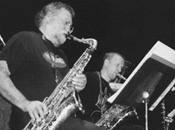 Somewhere
during the second half of the piece, Guy gave Gustafsson an executive
officer role as second conductor. Guy continued his duties, playing
and directing composed sections for the left half of the orchestra—Crispell,
Lytton, Robertson, Parker, and himself. Gustafsson cased his baritone
sax, swung around, and theatrically began to conduct, improvising,
the right half—Bauer, Holmlander, Strid and Koch (bass and contrabass
clarinet). He motioned randomly for swells, stops, cutouts, and tremolos.
Interestingly, he began to hold up index cards. He grabbed one with
a big, written "S" and held it in the face of Bauer, cueing him. Bauer
erupted with a huge sine wave that went from the upper to low register
on his trombone. Then Gustafsson flashed a card with disordered "up"
arrows all over it to each of the horns. High stabs followed (see
where this is going?). He was joyous to watch, full of energy, and
remarkably tuned in to Guy's half while directing his own. Toward
the end of the piece, a superb duet between Guy and Crispell duet
went off perfectly, given a complicated slow tempo. Hans Koch joined
the duet on contrabass clarinet, following scraps of the lead and
improvising as directed. Somewhere
during the second half of the piece, Guy gave Gustafsson an executive
officer role as second conductor. Guy continued his duties, playing
and directing composed sections for the left half of the orchestra—Crispell,
Lytton, Robertson, Parker, and himself. Gustafsson cased his baritone
sax, swung around, and theatrically began to conduct, improvising,
the right half—Bauer, Holmlander, Strid and Koch (bass and contrabass
clarinet). He motioned randomly for swells, stops, cutouts, and tremolos.
Interestingly, he began to hold up index cards. He grabbed one with
a big, written "S" and held it in the face of Bauer, cueing him. Bauer
erupted with a huge sine wave that went from the upper to low register
on his trombone. Then Gustafsson flashed a card with disordered "up"
arrows all over it to each of the horns. High stabs followed (see
where this is going?). He was joyous to watch, full of energy, and
remarkably tuned in to Guy's half while directing his own. Toward
the end of the piece, a superb duet between Guy and Crispell duet
went off perfectly, given a complicated slow tempo. Hans Koch joined
the duet on contrabass clarinet, following scraps of the lead and
improvising as directed.
"Inscape-Tableaux" ended as it had begun: collectively. The final
ten minutes featured each musician with spurious solos, pulling from
the written material and adding further to it. The orchestra came
together on a final climactic note, on a dime. The audience exploded
and so did I. The music was incredibly smart and the performance was
infectious, especially considering how fragile it was. The vulnerability
was not so much in the performance of a single musician, or how well
that player could add to the material within allotted free space,
but in the simple act of a missed cue, or discoloring the progressions
with a sour note. It went off without a hitch.
Having spent the last several months with the music of the Barry Guy
New Orchestra, live and captured, I can conclude that Guy has set
a new precedent for how music can be approached, perhaps beyond what
he has established with the LJCO. Only ten musicians large, the sound
of this orchestra is thick. Small groups would do well to take elements
of what he has achieved and make it their own. Which is what jazz
is about, right?
As wonderful as the music was, I have to mention how easily it could
have turned out otherwise. Of course all of the musicians showed up
for their respective gigs. A good thing. But one thing I noticed was
how well the succession of concerts was organized. Getting
to and from a venue was never a problem, and there was always plenty
of time to settle in before the music began. Obviously the music I
heard was catered to a certain audience. Most listeners attended like
shows, and no one could have had a valid gripe about the coordination
of the gigs. It was flawless. I'd venture to guess that there was
a continuous stream of communication between venues to complement
some serious, effective planning. My only complaint is that I couldn't
have stayed longer. Sten Sandell's trio played the following night.
Later in the week Vancouver heard Tim Berne's Hard Cell, Ellery Eskelin
with Parkins and Black, Dave Douglas' New Quintet, Louis Sclavis,
Emmylou Harris, and the Uri Caine Trio. I'll just have to budget better
for next year.
|
|
|
|
|

